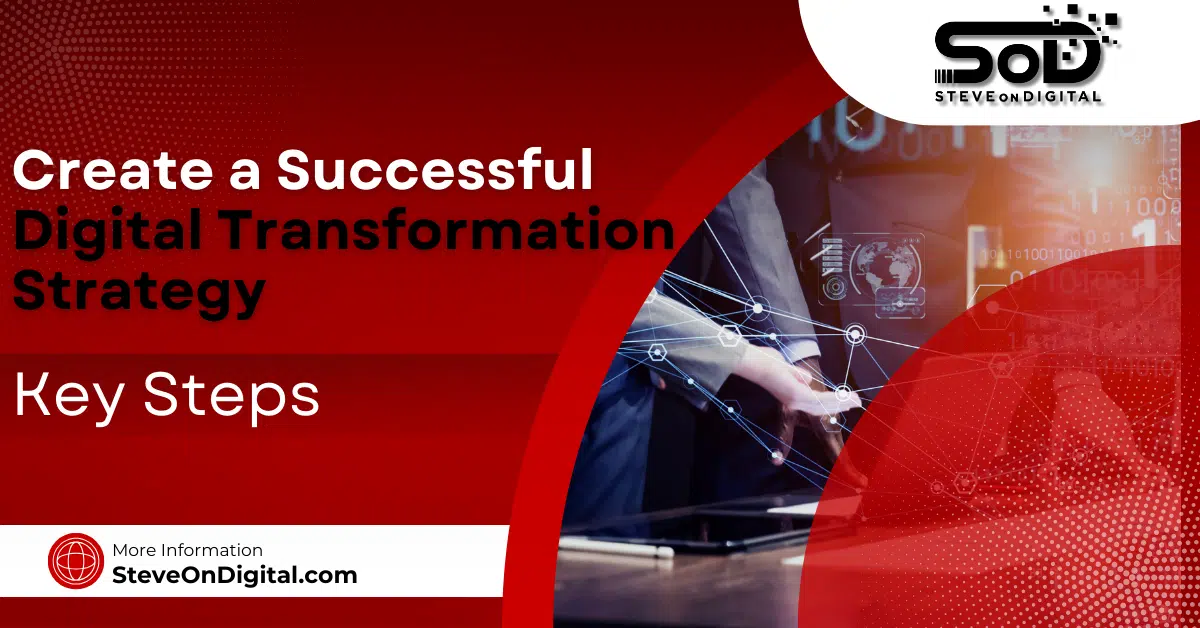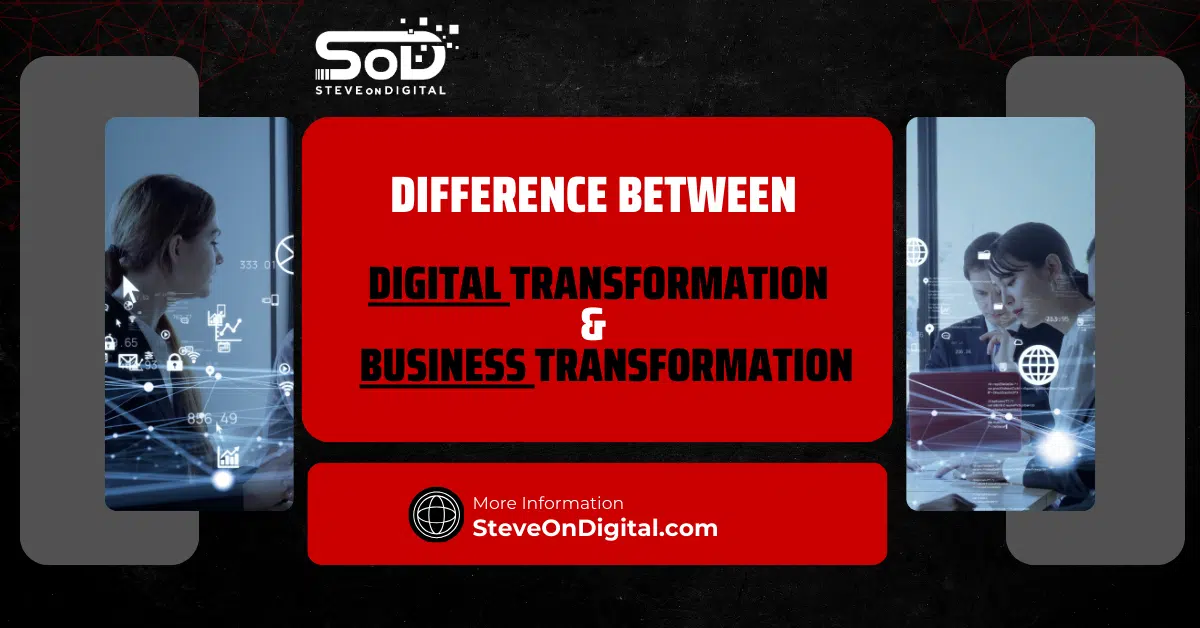To create a successful digital transformation strategy, evaluate your current business processes and technologies. Establish specific, measurable goals that align with your overall business objectives. Develop a clear roadmap that outlines steps and phases for implementation, ensuring you allocate the necessary resources like budget, technology, and personnel. Regularly track progress with realistic timelines and milestones.
Digital transformation is essential for staying competitive in today’s market. According to Flexera, 74% of organizations prioritize digital transformation, and COVID-19 has accelerated these initiatives for 97% of companies. By carefully planning and executing your strategy, you can significantly enhance operational efficiency, and customer satisfaction, and drive revenue growth.
I’m Steve, a digital transformation expert with a strong background in electrical engineering, an MBA, and a master’s in Project Management. I excel at helping SMEs navigate the digital landscape with practical insights. Let’s begin!
Understanding Digital Transformation
Digital transformation involves integrating digital technology into all areas of a business, fundamentally changing how you operate and deliver value to customers. It’s about using digital tools to solve traditional problems and improving business processes to enhance efficiency and customer satisfaction.
Importance of Digital Transformation
According to a study by Flexera, 74% of organizations consider digital transformation a top priority, showing a significant increase from previous years (Exploding Topics). The COVID-19 pandemic accelerated these initiatives, with 97% of companies stating it sped up their digital transformation by an average of six years (Exploding Topics). This shift highlights the urgent need for businesses to adapt to the digital age.
Key Elements of a Digital Transformation Strategy
Creating a successful digital transformation strategy involves several critical components. Here’s a comprehensive look at what you need to consider:
| Key Element | Description |
|---|---|
| Assess Current State | Evaluate existing business processes and technologies to identify improvement areas. |
| Set Clear Goals | Establish specific, measurable goals that align with business objectives. |
| Align with Objectives | Ensure the strategy supports overall business goals. |
| Develop a Roadmap | Create a step-by-step plan for implementation. |
| Allocate Resources | Identify necessary resources including budget, technology, and personnel. |
| Track Progress | Set realistic timelines and milestones for tracking progress. |
Assessing Current Business State
Before embarking on any transformation, it’s crucial to evaluate your existing business processes and technologies. This step helps identify areas that need improvement and opportunities for digital integration. For instance, upgrading obsolete IT infrastructure is a top reason for increased IT budgets in 56% of organizations (DOIT).
Setting Clear Goals
Establishing specific, measurable goals for your digital transformation efforts is essential. These goals should align with your overall business objectives. According to McKinsey, firms with advanced digital maturity report a 45% revenue growth, compared to 15% for lower maturity firms (Whatfix). This statistic underscores the importance of setting clear, achievable goals.
Aligning with Business Objectives
Your digital transformation strategy should support and enhance your business goals. Whether it’s improving operational efficiency, enhancing customer experience, or driving revenue growth, aligning your strategy with these objectives ensures that digital transformation efforts contribute to the overall success of your business.
Developing a Roadmap
A clear roadmap is vital for achieving your digital transformation goals. This roadmap should outline the steps and phases of the transformation process, ensuring a structured and manageable approach.
Phased Implementation Plan
Breaking down your strategy into manageable phases makes execution easier and more organized. For example, companies that have phased their digital transformation efforts reported better management of resources and clearer progress tracking (Outsource Accelerator).
Resource Allocation
Identify and allocate the necessary resources, including budget, technology, and personnel. According to a report by SWZD, 45% of companies are investing in new IT projects, and 36% are supporting remote workforces (Outsource Accelerator). Proper resource allocation is crucial for the smooth execution of your strategy.
Timeline and Milestones
Setting realistic timelines and milestones helps track progress and maintain momentum. This approach ensures that each phase of the transformation is completed on schedule, contributing to the overall success of the initiative.
Choosing the Right Technologies
Selecting the right digital tools and technologies is critical for a successful digital transformation strategy. The choices you make here can significantly impact your organization’s efficiency, customer satisfaction, and overall success.
Evaluating Digital Tools
When evaluating digital tools, consider the following criteria:
- Compatibility: Ensure that the new technology integrates well with your existing systems. According to Gartner, 87% of organizations use a multi-cloud approach to enhance compatibility and flexibility (Outsource Accelerator).
- Scalability: The tool should be able to grow with your business. Flexera notes that 74% of Chief Supply Chain Officers stress the importance of hybrid cloud integration for scalability (DOIT).
- Cost-Effectiveness: Balance between cost and functionality. SWZD reports that 56% of organizations plan to increase IT spending to upgrade infrastructure, reflecting the need for cost-effective solutions (DOIT).
Integrating Existing Technologies
Integration can be challenging but is crucial for a seamless digital transformation process. Here’s how you can do it effectively:
- Assess Current Systems: Identify which of your existing technologies are compatible with new digital tools. This ensures a smooth transition and minimizes disruption.
- Utilize Middleware Solutions: Middleware can act as a bridge between new and old systems, facilitating data exchange and operational continuity.
- Train Your Team: Ensure that your team is well-trained to handle the integrated systems, reducing downtime and improving efficiency.
Future-Proofing Technology Investments
To ensure long-term value from your technology investments:
- Adopt Flexible Solutions: Technologies like cloud computing and AI offer flexibility and adaptability to future needs. According to McKinsey, 52% of companies have allocated more than 5% of their budget to AI initiatives (DOIT).
- Stay Updated: Regularly update your systems to keep up with technological advancements. This helps in maintaining competitiveness and operational efficiency.
- Invest in Scalable Infrastructure: Ensure your infrastructure can scale up or down based on your business requirements, allowing for growth without significant additional investment.
Enhancing Customer and Employee Experiences
Improving the experiences of both customers and employees is a key aspect of a successful digital transformation strategy.
Customer Experience Improvement
Enhancing customer interactions and satisfaction involves:
- Personalization: Use data analytics to understand customer preferences and tailor experiences accordingly. Data-driven companies are 23 times more likely to acquire new customers (Whatfix).
- Omnichannel Support: Provide consistent customer service across all channels, including online, in-store, and mobile. This ensures a seamless experience for customers.
- Feedback Mechanisms: Implement robust feedback systems to gather customer insights and make necessary improvements.
| Strategy | Description |
|---|---|
| Personalization | Use data analytics to tailor customer experiences. |
| Omnichannel Support | Provide consistent service across all channels. |
| Feedback Mechanisms | Implement systems to gather and act on customer insights. |
Employee Experience Enhancement
Boosting employee engagement and productivity can be achieved through:
- Digital Tools: Provide employees with the right digital tools to perform their tasks efficiently. According to Infosys, 86% of organizations believe that workplace transformation enhances productivity and customer experience (DOIT).
- Training Programs: Invest in continuous training to help employees adapt to new technologies and processes.
- Flexible Work Arrangements: Support remote work and flexible schedules to improve work-life balance and job satisfaction.
Leveraging Customer Feedback
Using customer feedback effectively can drive innovation and improvement:
- Regular Surveys: Conduct regular surveys to understand customer needs and expectations.
- Actionable Insights: Analyze feedback to derive actionable insights and implement changes that enhance customer satisfaction.
- Continuous Improvement: Use feedback as part of a continuous improvement process to keep refining your strategies and offerings.
Building a Digital Culture
Creating a culture that embraces digital transformation and continuous improvement is vital for long-term success.
Encouraging Innovation
Fostering a culture of innovation involves:
- Incentivizing Creativity: Encourage employees to come up with innovative solutions by offering rewards and recognition.
- Collaborative Environment: Promote collaboration across departments to leverage diverse perspectives and ideas.
- Supportive Leadership: Leaders should champion innovation and provide the necessary resources and support to bring new ideas to life.
Training and Development
Investing in employee training to develop digital skills is crucial:
- Continuous Learning: Offer ongoing training programs to help employees stay updated with the latest technologies and trends.
- Skill Development: Focus on developing skills that are critical for digital transformation, such as data analysis, AI, and cybersecurity.
- Mentorship Programs: Establish mentorship programs where experienced employees can guide and support those new to digital technologies.
Leadership and Vision
Effective leadership plays a key role in guiding digital transformation:
- Clear Vision: Leaders should have a clear vision for digital transformation and communicate it effectively to the entire organization.
- Lead by Example: Demonstrate a commitment to digital transformation by actively participating in initiatives and encouraging others to do the same.
- Empower Employees: Empower employees by giving them the autonomy to make decisions and contribute to the transformation process.
Monitoring and Measuring Success
To ensure the success of your digital transformation initiatives, it’s important to monitor and measure progress regularly.
Key Performance Indicators
Define and track KPIs to measure the effectiveness of your digital transformation efforts:
- Operational Efficiency: Measure improvements in operational processes and efficiency.
- Customer Satisfaction: Track customer satisfaction levels through surveys and feedback.
- Revenue Growth: Monitor revenue growth and profitability as a result of digital transformation.
Continuous Improvement
Implement a continuous improvement process to refine strategies and achieve better results:
- Regular Reviews: Conduct regular reviews of your digital transformation initiatives to identify areas for improvement.
- Feedback Loops: Establish feedback loops to gather insights from employees and customers.
- Iterative Approach: Use an iterative approach to make incremental improvements over time.
Data-Driven Decisions
Use data analysis to inform and adjust your strategies:
- Data Collection: Collect relevant data from various sources to gain insights into your digital transformation progress.
- Analytics Tools: Utilize analytics tools to analyze data and derive actionable insights.
- Informed Decisions: Make informed decisions based on data analysis to drive continuous improvement and achieve better outcomes.
Managing Change Effectively
Managing change is crucial for a successful digital transformation. Change management addresses the challenges that come with implementing new technologies and processes. Here’s how to handle it effectively.
Communication Strategies
Effective communication is key to managing change. Here’s what I focus on:
- Transparent Communication: Keep everyone informed about the changes, the reasons behind them, and the benefits. Clear communication helps to reduce uncertainty and build trust.
- Regular Updates: Provide regular updates through emails, meetings, and internal platforms. This ensures that everyone is on the same page and aware of the progress.
- Feedback Channels: Establish channels for employees to ask questions and provide feedback. This helps to address concerns and gather valuable insights.
Stakeholder Engagement
Engaging stakeholders is essential for gaining buy-in and support. Here are some strategies I use:
- Identify Key Stakeholders: Identify individuals and groups who will be impacted by the transformation. This includes employees, customers, and partners.
- Involve Them Early: Engage stakeholders early in the planning process. Their input can provide valuable perspectives and help in creating a more comprehensive strategy.
- Regular Check-Ins: Schedule regular check-ins with stakeholders to discuss progress, address concerns, and gather feedback. This ongoing dialogue ensures continued support and alignment.
Overcoming Resistance
Resistance to change is natural. Here’s how I address it:
- Understand the Root Cause: Identify the reasons behind the resistance. It could be fear of the unknown, lack of understanding, or concerns about job security.
- Provide Training and Support: Offer training programs to help employees adapt to new technologies and processes. Support them through the transition with resources and assistance.
- Highlight Benefits: Emphasize the benefits of the transformation for both the organization and the employees. Show how the changes will improve their work and the overall success of the business.
Case Studies of Successful Digital Transformations
Real-life examples can provide valuable insights and inspiration. Here are some successful digital transformation initiatives.
Small and Medium Enterprises
- XYZ Corp: A small manufacturing company that integrated IoT to streamline operations, resulting in a 30% increase in efficiency and a 20% reduction in operational costs.
- ABC Retail: A medium-sized retail business that adopted an omnichannel strategy, leveraging data analytics to personalize customer experiences and boost sales by 25%.
Large Corporations
- General Electric: Implemented a company-wide digital transformation, focusing on IoT and data analytics. This initiative led to significant improvements in operational efficiency and innovation.
- Ford Motor Company: Embraced digital transformation by integrating AI and machine learning into their production processes, enhancing quality control and reducing costs.
Industry-Specific Transformations
- Healthcare: Hospitals and clinics using AI to improve diagnostics and patient care. For instance, Mount Sinai Health System’s use of AI for predictive analytics has enhanced patient outcomes.
- Finance: Banks adopting blockchain technology for secure transactions and improved transparency. JP Morgan’s implementation of blockchain for interbank transactions is a notable example.
Leveraging Emerging Technologies
Emerging technologies play a pivotal role in digital transformation. Here’s how they can be utilized.
Artificial Intelligence and Machine Learning
AI and ML have numerous applications in business:
- Predictive Analytics: Use AI to analyze data and predict future trends, helping in decision-making and strategy formulation.
- Automation: Implement AI-driven automation to streamline repetitive tasks, increasing efficiency and reducing errors.
Internet of Things (IoT)
IoT can transform business operations by:
- Real-Time Monitoring: Use IoT devices to monitor processes and equipment in real-time, improving maintenance and reducing downtime.
- Data Collection: Gather vast amounts of data from connected devices to gain insights into operations and customer behavior.
Blockchain Technology
Blockchain offers secure and transparent solutions:
- Secure Transactions: Implement blockchain for secure, tamper-proof transactions, enhancing trust and security.
- Supply Chain Transparency: Use blockchain to track products through the supply chain, improving transparency and efficiency.
| Technology | Application/Benefit |
|---|---|
| Artificial Intelligence (AI) | Predictive analytics, automation of repetitive tasks. |
| Internet of Things (IoT) | Real-time monitoring, data collection for insights. |
| Blockchain | Secure transactions, supply chain transparency. |
Addressing Security and Privacy Concerns
Ensuring data security and privacy is critical during digital transformation.
Cybersecurity Measures
Effective cybersecurity practices include:
- Regular Audits: Conduct regular security audits to identify vulnerabilities and implement necessary measures.
- Employee Training: Train employees on cybersecurity best practices to prevent breaches caused by human error.
Data Privacy Regulations
Compliance with data privacy laws is essential:
- Understand Regulations: Familiarize yourself with relevant data privacy laws such as GDPR and CCPA.
- Implement Compliance Measures: Ensure that your systems and processes comply with these regulations to avoid legal issues and protect customer data.
Risk Management
Identify and mitigate risks associated with digital transformation:
- Risk Assessment: Conduct thorough risk assessments to identify potential threats.
- Mitigation Strategies: Develop strategies to mitigate identified risks, such as implementing robust security measures and creating contingency plans.
Final Thoughts
Creating a successful digital transformation strategy is a comprehensive process that requires careful planning and execution. By addressing change management, leveraging emerging technologies, and ensuring data security, you can navigate the digital transformation journey effectively. Remember, a well-planned strategy not only enhances operational efficiency but also drives growth and innovation.
By focusing on these key areas, I aim to help small business owners like you achieve digital transformation success. If you have any questions or need further assistance, feel free to reach out. Together, we can take your business forward in the digital age.




